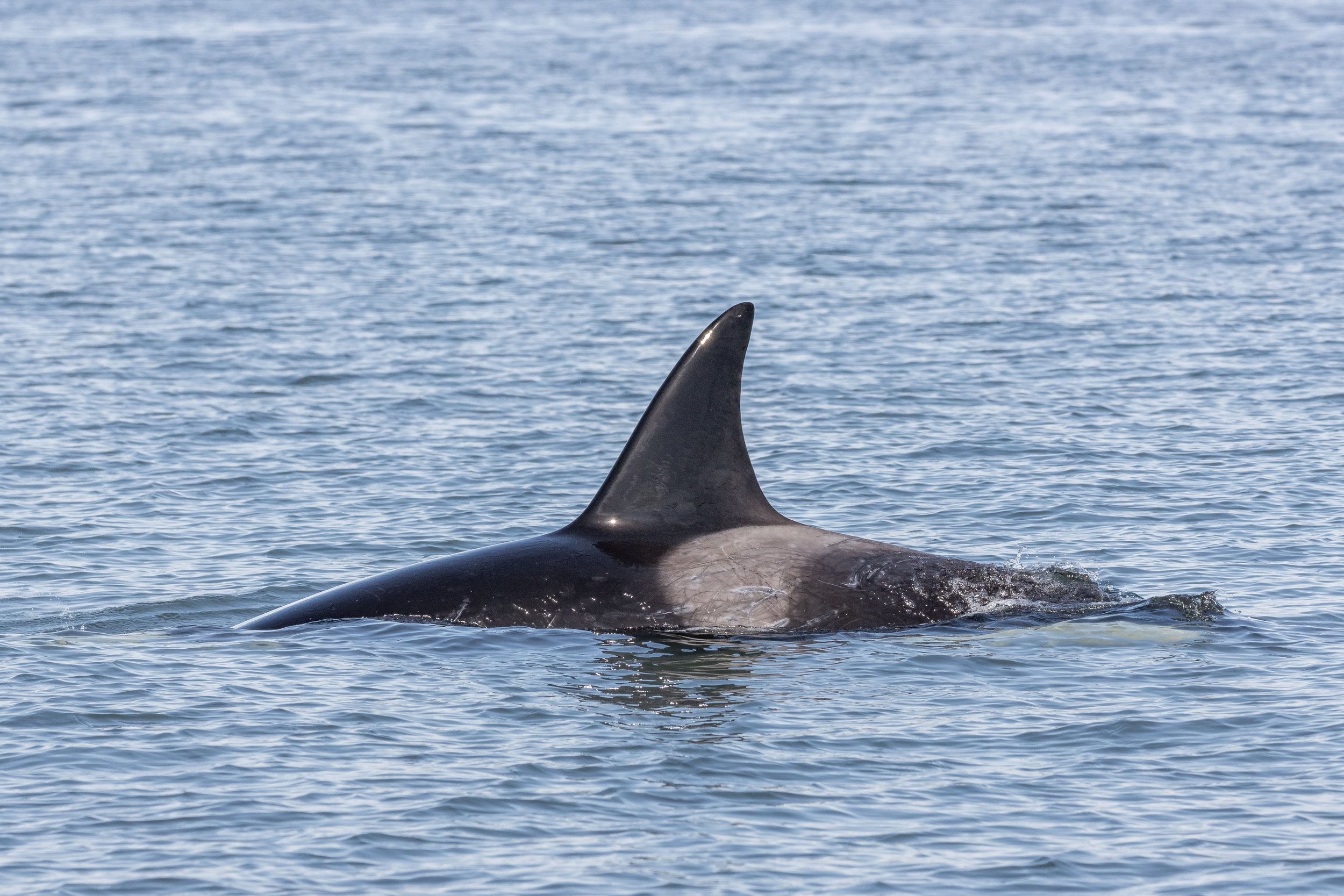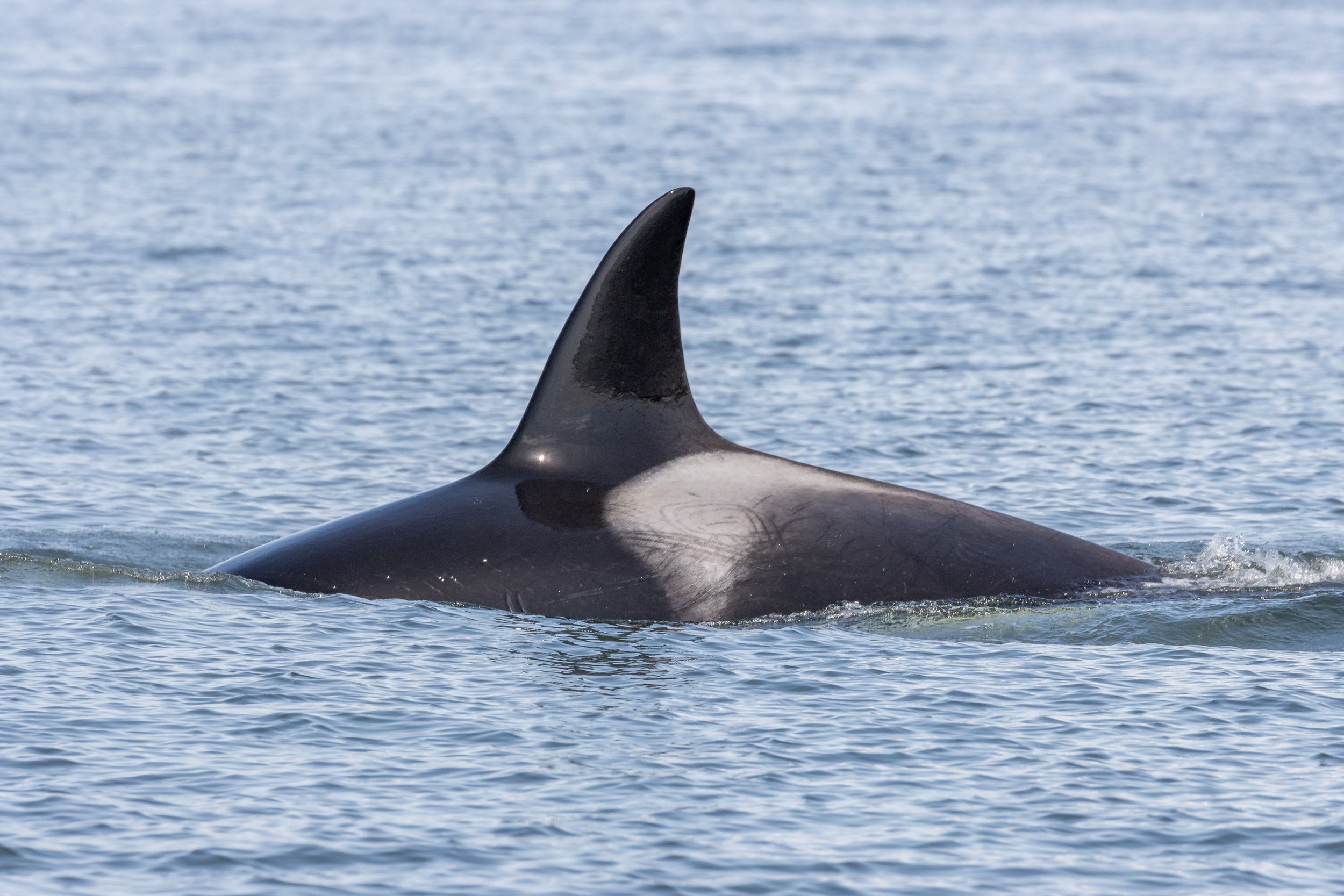April 14, 2023 -The T071B's and the T124D's in the Strait
Transient Orca, also known as Bigg's Orca, are a unique and highly adaptable ecotype of orca found in the coastal waters of British Columbia and one of the main whale types we see on our tours. These apex predators are known for their opportunistic hunting behaviour, feeding on a variety of prey including seals, sea lions, and other marine mammals. While they may be fearsome hunters, Transient Orca are not invincible, and can sometimes sustain injuries during their encounters with their prey.
In recent years, whale watchers in British Columbia have noticed an increase in scars on the transient Orca’s bodies. These scars are believed to be the result of interactions with other marine mammals, particularly those with sharp teeth such as seals and sea lions.
Transient Orcas are known to hunt in pods, often targeting individual prey animals and using their superior intelligence and strength to overpower them. During these hunts, they may sustain injuries from the prey's defensive actions. The scars on transient Orcas can range from small cuts and scratches to deep gouges that may take months to heal. While some scars may be superficial, others can have long-term impacts on the animal's health and behaviour. For example, a deep wound may cause discomfort and affect the whale's ability to swim or hunt effectively, as we noticed a few years ago in 2019 when T137A Jack had a bad injury, but he has since recovered.
One of the most fascinating aspects of scarring in Transient Orca is the unique patterns and shapes that can be seen on their bodies. These scars are used by researchers to identify individual whales and track their movements and behaviour over time. You can see in our photos how unique these scars are for each whale!
Despite the potential negative effects of scarring, transient Orcas seem to be able to adapt and thrive in their environment. They are highly resilient animals that are capable of healing from injuries and adjusting their behaviour to compensate for any physical limitations. Even in this group, it was hard to figure out who had a fluke deformity, since they had adjusted their behaviour and seemed unaffected by it!
Moreover, these scars serve as a testament to the incredible lives that transient Orcas lead. They are fierce and skilled predators that are constantly testing their limits and pushing the boundaries of what is possible. The scars they bear are a testament to the challenges they have overcome and the triumphs they have achieved. Today’s group of orca was found in the Strait of Georgia and consisted of the T071Bs and T124Ds travelling together.
T071B ♀ Hood (2000)
T071B1 Zengo (2013)
T071B2 Tasli (2018)
T124D ♀ Field (1996)
T124D1 Salish II (2014)
T124D3 (2022)
Juvenile Bald Eagle taking flight! Photo by Aly Kohlman.
Check out those talons! Photo by Aly Kohlman.
A Harbour Seal enjoying the Sunshine! Photo by Aly Kohlman.
A cuddle puddle of Steller Sea Lions on Sticky Rocks. Photo by Aly Kohlman.
Look at the size of this adult male Steller Sea Lion. Photo by Aly Kohlman.
T071B Hood surfacing. Photo by Aly Kohlman.
T124D Field, T124D3, and T071B Hood. Photo by Aly Kohlman.
T124D Field and T124D3. Photo by Aly Kohlman.
T071B Hood withT071B2 Tasli. Photo by Aly Kohlman.
T071B2 Tasli and T124D Field. Photo by Aly Kohlman.
T071B Hood. Photo by Aly Kohlman.
T124D Field. Photo by Aly Kohlman.
T071B Hood and T071B2 Tasli. Photo by Aly Kohlman.
The Canadian Coast Guard Hovercraft passing through Porlier Pass. Photo by Aly Kohlman.
A huge raft of sea lions in Ruxton Passage. Photo by Cheyenne Brewster.
These sea lions were curious about the boat! Photo by Cheyenne Brewster.
A large haul out of sea lions in Ruxton Passage, Both local species are in this photo, can you spot both?Photo by Cheyenne Brewster.
T124D Field, T124D3, T071B Hood and T071B2 Tasli. Photo by Cheyenne Brewster.
T124D Field and T124D3. Photo by Cheyenne Brewster.
T071B Hood. Photo by Cheyenne Brewster.
T124D Field. Photo by Cheyenne Brewster.
T071B Hood. Photo by Cheyenne Brewster.
T124D Field in front of another who just dipped below the surface. That black lump is the other orcas’ tail peduncle! Photo by Cheyenne Brewster.
T071B Hood. Photo by Cheyenne Brewster.
T124D3 is collecting a lot of deep scars already! Photo by Cheyenne Brewster.
T124D3 shows off their tail as they dive down! Photo by Cheyenne Brewster.
T071B Hood also sporting new scars. Photo by Cheyenne Brewster.
Determined from another sequence of photos, T071B2 Talsi, shown here in front of T071B1 Zengo, has a slight deformity to their tail! That wasn’t stopping them from throwing it around though! Photo by Cheyenne Brewster.
T071B1 Zengo making an appearance in front of another’s tail. Photo by Cheyenne Brewster.
Did you know you can ID from the eyepatch? This is T124D1 Salish II! Photo by Cheyenne Brewster.
T124D1 Salish II has so many new scars, its hard to keep track of! Photo by Cheyenne Brewster.
T124D Field. Photo by Cheyenne Brewster.
Someone was feeling playful! Photo by Cheyenne Brewster.
Flukes up! Photo by Cheyenne Brewster.
T071B Hood. Photo by Cheyenne Brewster.
T071B2 Tasli. Photo by Cheyenne Brewster.




































